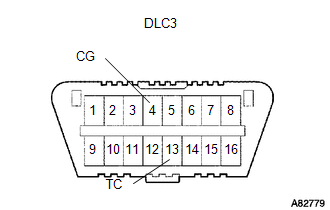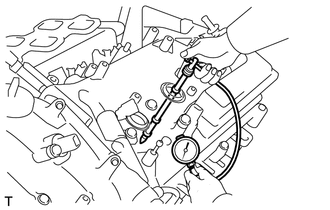-
Faulty ignitions:
- Incorrect valve timing
- Fouled, shorted or improperly gapped plugs
- Incorrect valve clearance (valve lash adjuster)
- Leaks in intake or exhaust valves
- Leaks in cylinders
| Last Modified: 08-28-2024 | 6.11:8.1.0 | Doc ID: RM100000000VICK |
| Model Year Start: 2016 | Model: Sienna | Prod Date Range: [12/2015 - 08/2016] |
| Title: 2GR-FE ENGINE MECHANICAL: ENGINE: ON-VEHICLE INSPECTION; 2016 MY Sienna [12/2015 - 08/2016] | ||
ON-VEHICLE INSPECTION
PROCEDURE
1. INSPECT ENGINE COOLANT
2. INSPECT ENGINE OIL
3. INSPECT BATTERY
4. INSPECT AIR CLEANER FILTER ELEMENT SUB-ASSEMBLY
(a) Remove the air cleaner sub-assembly (See page
![2016 MY Sienna [12/2015 - 08/2016]; 2GR-FE (ENGINE CONTROL): THROTTLE BODY: REMOVAL+](/t3Portal/stylegraphics/info.gif) ).
).
(b) Remove the air cleaner filter element sub-assembly.
(c) Visually check that the air cleaner filter is not excessively damaged or oily. If necessary, replace the air cleaner filter.
HINT:
- If there is any dirt or a blockage in the air cleaner filter element sub-assembly, clean it with compressed air.
- If any dirt or a blockage remains even after cleaning the air cleaner filter element sub-assembly with compressed air, replace it.
(d) Install the air cleaner filter element sub-assembly.
(e) Install the air cleaner sub-assembly (See page
![2016 MY Sienna [12/2015 - 08/2016]; 2GR-FE (ENGINE CONTROL): THROTTLE BODY: INSTALLATION+](/t3Portal/stylegraphics/info.gif) ).
).
5. INSPECT FAN AND GENERATOR V BELT
6. INSPECT V-RIBBED BELT TENSIONER ASSEMBLY
(a) Remove the fan and generator V belt (See page
![2016 MY Sienna [12/2015 - 08/2016]; 2GR-FE ENGINE MECHANICAL: DRIVE BELT: REMOVAL](/t3Portal/stylegraphics/info.gif) ).
).
(b) Check that nothing is caught in the tensioner by turning it clockwise and counterclockwise. If a malfunction exists, replace the tensioner.
(c) Install the fan and generator V belt (See page
![2016 MY Sienna [12/2015 - 08/2016]; 2GR-FE ENGINE MECHANICAL: DRIVE BELT: INSTALLATION](/t3Portal/stylegraphics/info.gif) ).
).
7. INSPECT SPARK PLUG
8. INSPECT VALVE LASH ADJUSTER NOISE
(a) Rev up the engine several times. Check that the engine does not emit unusual noises.
If unusual noises occur, warm up the engine and idle it for over 30 minutes. Then perform the preceding inspection.
HINT:
If any defects or problems are found during the preceding inspection, perform lash adjuster inspection (See page
![2016 MY Sienna [12/2015 - 08/2016]; 2GR-FE ENGINE MECHANICAL: ENGINE UNIT: INSPECTION+](/t3Portal/stylegraphics/info.gif) ).
).
9. INSPECT IGNITION TIMING
(a) Start the engine and warm it up until the engine coolant temperature reaches 75°C (167°F) or more.
(b) When using the Techstream:
Check the ignition timing.
(1) Connect the Techstream to the DLC3.
(2) Start the engine and run it at idle.
(3) Turn the Techstream main switch on.
(4) Enter the following menus: Powertrain / Engine / Data List / IGN Advance.
Standard ignition timing:
9.5 to 24.5° BTDC at idle
NOTICE:
- Check the ignition timing with the cooling fans off.
- Turn off all electrical systems and the A/C.
- When checking the ignition timing, the transaxle should be in neutral or park.
HINT:
Refer to the Techstream operator manual for further details.
(5) Check that the ignition timing advances immediately when the engine speed is increased.
(6) Enter the following menus: Powertrain / Engine / Active Test / Connect the TC and TE1.
(7) Monitor IGN Advance.
(8) Perform the Active Test.
Standard ignition timing:
8 to 12° BTDC at idle
NOTICE:
When checking the ignition timing, the transaxle should be in neutral or park.
HINT:
Refer to the Techstream operator manual for further details.
(c) When not using the Techstream:
|
(1) Using SST, connect terminals 13 (TC) and 4 (CG) of the DLC3. SST: 09843-18040 NOTICE:
|
|
(2) Remove the V-bank cover sub-assembly (See page
![2016 MY Sienna [12/2015 - 08/2016]; 2GR-FE ENGINE MECHANICAL: ENGINE ASSEMBLY: REMOVAL+](/t3Portal/stylegraphics/info.gif) ).
).
(3) Connect the timing light tester probe to the ignition coil wire for No. 1 cylinder.
NOTICE:
Use a timing light that detects primary signals.
(4) Check the ignition timing at idle.
Standard ignition timing:
8 to 12° BTDC at idle
NOTICE:
When checking the ignition timing, the transaxle should be in the neutral or park.
HINT:
Run the engine at 1000 to 1300 rpm for 5 seconds, and then check that the engine rpm returns to idle speed.
(5) Disconnect terminals 13 (TC) and 4 (CG) of the DLC3.
(6) Check the ignition timing at idle.
Standard ignition timing:
9.5 to 24.5° BTDC at idle
(7) Confirm that the ignition timing advances immediately when the engine rpm is increased.
(8) Remove the timing light from the engine.
(9) Install the V-bank cover sub-assembly (See page
![2016 MY Sienna [12/2015 - 08/2016]; 2GR-FE ENGINE MECHANICAL: ENGINE ASSEMBLY: INSTALLATION+](/t3Portal/stylegraphics/info.gif) ).
).
10. INSPECT ENGINE IDLE SPEED
(a) Connect the Techstream to the DLC3.
(b) Start the engine and warm it up until the engine coolant temperature reaches 75°C (167°F) or more.
(c) Turn the Techstream main switch on.
(d) Enter the following menus: Powertrain / Engine / Data List / Engine Speed.
(e) Read the value displayed on the tester.
Standard idle speed:
600 to 700 rpm
NOTICE:
- Check the idle speed with the cooling fans off.
- Turn off all the electrical systems and the A/C.
- When checking the idle speed, the transaxle should be in neutral or park.
HINT:
Refer to the Techstream operator manual for further details.
11. INSPECT COMPRESSION
(a) Warm up the engine until the engine coolant temperature reaches 75°C (167°F) or more.
(b) Stop the engine.
(c) Remove the 6 spark plugs (See page
![2016 MY Sienna [12/2015 - 08/2016]; 2GR-FE (ENGINE CONTROL): IGNITION COIL AND SPARK PLUG: REMOVAL](/t3Portal/stylegraphics/info.gif) ).
).
(d) Disconnect the injector connectors.
|
(e) Check the cylinder compression pressure. (1) Insert a compression gauge into the spark plug hole. (2) While cranking the engine, measure the compression pressure. Standard compression pressure: 1.3 MPa (13 kgf/cm2, 189 psi) Minimum pressure: 0.98 MPa (10 kgf/cm2, 142 psi) Difference between each cylinder: 0.1 MPa (1.0 kgf/cm2, 15 psi) NOTICE:
(3) If the cylinder compression is low, pour a small amount of engine oil into the cylinder through the spark plug hole and inspect again. HINT:
|
|
(f) Connect the injector connectors.
(g) Install the 6 spark plugs (See page
![2016 MY Sienna [12/2015 - 08/2016]; 2GR-FE (ENGINE CONTROL): IGNITION COIL AND SPARK PLUG: INSTALLATION](/t3Portal/stylegraphics/info.gif) ).
).
12. INSPECT CO/HC
HINT:
This check determines whether or not the idle CO/HC complies with regulations.
(a) Start the engine.
(b) Keep the engine speed at 2500 rpm for approximately 180 seconds.
(c) Insert the CO/HC meter testing probe at least 40 cm (1.31 ft.) into the tailpipe during idle.
(d) Immediately check CO/HC concentration during idle and when running at 2500 rpm.
HINT:
When performing the 2 mode (with the engine idling/running at 2500 rpm) test, follow the measurement order determined by applicable local regulations.
If the CO/HC concentration does not comply with the regulations, perform troubleshooting in the order given below.
(1) Check for DTCs (See page
![2016 MY Sienna [12/2015 - 08/2016]; 2GR-FE (ENGINE CONTROL): SFI SYSTEM: DIAGNOSTIC TROUBLE CODE CHART](/t3Portal/stylegraphics/info.gif) ).
).
(2) See the table below for possible causes, then inspect and correct the applicable causes if necessary.
|
CO |
HC |
Problem |
Cause |
|---|---|---|---|
|
Normal |
High |
Rough idle |
|
|
Low |
High |
Rough idle (Fluctuating HC reading) |
|
|
High |
High |
Rough idle (Black smoke from exhaust) |
|
|
|
|

